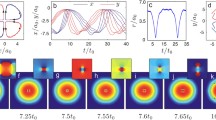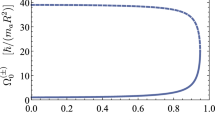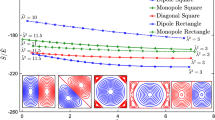Abstract
We study quantum vortex states consisting of a ring of vortices with alternating sign, in a homogeneous superfluid confined to a circular domain. We find an exact stationary solution of the point vortex model for the neutral vortex necklace. We investigate the stability of the necklace state within both the point-vortex model and the Gross–Pitaevskii equation describing a trapped atomic Bose–Einstein condensate at low temperature. The point-vortex stationary states are found to also be stationary states of the Gross–Pitaevskii equation provided the finite thickness of the outer fluid boundary is accounted for. Under significant perturbation, the Gross–Pitaevskii evolution and point-vortex model exhibit instability as expected for metastable states. The perturbed vortex necklace exhibits sensitivity to the perturbation, suggesting a route to seeding vortex chaos or quantum turbulence.






Similar content being viewed by others
Notes
In preparing this manuscript we discovered that this analytical result was found using a different approach in the doctoral thesis of Q. Dai [30].
For similar reasons, it is not desirable to work in a rotating frame, as the neutral necklace is non-rotating.
A detailed treatment of integrability is given by Newton [50].
References
H. Helmholtz, Lond. Edinb. Dubl. Philos. Mag. J. Sci. 33(226), 485 (1867). https://doi.org/10.1080/14786446708639824
Gustav Robert Kirchhoff, Vorlesungenüber Mathematische Physik: Mechanik, vol. 1 (Teubner, Stuttgart, 1876)
E.A. Novikov, Zhurnal Eksperimental noi i Teoreticheskoi Fiziki 68, 1868 (1975)
L. Onsager, Il Nuovo Cimento (1943–1954) 6(2), 279 (1949). https://doi.org/10.1007/BF02780991
G. Gauthier, M.T. Reeves, X. Yu, A.S. Bradley, M.A. Baker, T.A. Bell, H. Rubinsztein-Dunlop, M.J. Davis, T.W. Neely, Science 364(6447), 1264 (2019). https://doi.org/10.1126/science.aat5718
S.P. Johnstone, A.J. Groszek, P.T. Starkey, C.J. Billington, T.P. Simula, K. Helmerson, Science 364(6447), 1267 (2019). https://doi.org/10.1126/science.aat5793
T.W. Neely, E.C. Samson, A.S. Bradley, M.J. Davis, B.P. Anderson, Phys. Rev. Lett. 104(16), 160401 (2010). https://doi.org/10.1103/PhysRevLett.104.160401
K. Sasaki, N. Suzuki, H. Saito, Phys. Rev. Lett. 104(15), 150404 (2010). https://doi.org/10.1103/PhysRevLett.104.150404
L.M. Pismen, Vortices in Nonlinear Fields. From Liquid Crystals to Superfluids, from Non-Equilibrium Patterns to Cosmic Strings, 1st edn. (Oxford University Press, New York, 1999)
A.S. Bradley, B.P. Anderson, Phys. Rev. X 2(4), 041001 (2012). https://doi.org/10.1103/PhysRevX.2.041001
K. Henderson, C. Ryu, C. MacCormick, M.G. Boshier, New J. Phys. 11(4), 043030 (2009). https://doi.org/10.1088/1367-2630/11/4/043030
G. Gauthier, I. Lenton, N.M. Parry, M. Baker, M.J. Davis, H. Rubinsztein-Dunlop, T.W. Neely, Optica 3(10), 1136 (2016). https://doi.org/10.1364/OPTICA.3.001136
E.C. Samson, K.E. Wilson, Z.L. Newman, B.P. Anderson, Phys. Rev. A 93(2), 023603 (2016). https://doi.org/10.1103/PhysRevA.93.023603
T. Aioi, T. Kadokura, T. Kishimoto, H. Saito, Phys. Rev. X 1, 021003 (2011). https://doi.org/10.1103/PhysRevX.1.021003
M.T. Reeves, T.P. Billam, B.P. Anderson, A.S. Bradley, Phys. Rev. A 89(5), 053631 (2014). https://doi.org/10.1103/PhysRevA.89.053631
T.P. Simula, M.J. Davis, K. Helmerson, Phys. Rev. Lett. 113(16), 165302 (2014). https://doi.org/10.1103/PhysRevLett.113.165302
X. Yu, T.P. Billam, J. Nian, M.T. Reeves, A.S. Bradley, Phys. Rev. A 94(2), 023602 (2016). https://doi.org/10.1103/PhysRevA.94.023602
X. Yu, A.S. Bradley, Phys. Rev. Lett. 119(18), 185301 (2017). https://doi.org/10.1103/PhysRevLett.119.185301
M.M. Cawte, X. Yu, B.P. Anderson, A.S. Bradley, SciPost Phys. 6(3), 032 (2019). https://doi.org/10.21468/SciPostPhys.6.3.032
A. Groszek, M. Davis, T. Simula, SciPost Phys. 8(3), 039 (2020). https://doi.org/10.21468/SciPostPhys.8.3.039
M.T. Reeves, T.P. Billam, B.P. Anderson, A.S. Bradley, Phys. Rev. Lett. 110(10), 104501 (2013). https://doi.org/10.1103/PhysRevLett.110.104501
H. Aref, Fluid Dyn. Res. 39(1–3), 5 (2007). https://doi.org/10.1016/j.fluiddyn.2006.04.004
T.J. Stieltjes, Acta Math. 6, 321 (1885). https://doi.org/10.1007/BF02400421
H. Aref, J. Fluid Mech. 290(1), 167 (1995). https://doi.org/10.1017/S002211209500245X
M. Adler, J. Moser, Commun. Math. Phys. 61(1), 1 (1978). https://doi.org/10.1007/BF01609465
J. Kim, A. Fetter, Phys. Rev. A 70(4), 043624 (2004). https://doi.org/10.1103/PhysRevA.70.043624
L. Kurakin, J. Math. Fluid Mech. 7(3), S376 (2005). https://doi.org/10.1007/s00021-005-0166-6
J.B. Kadtke, L.J. Campbell, Phys. Rev. A 36(9), 4360 (1987). https://doi.org/10.1103/PhysRevA.36.4360
T. Bartsch, A. Pistoia, SIAM J. Appl. Math. 75(2), 726 (2015). https://doi.org/10.1137/140981253
T. Bartsch, Q. Dai, J. Differ. Equ. 260(3), 2275 (2016). https://doi.org/10.1016/j.jde.2015.10.002
C. Kuhl, J. Math. Anal. Appl. 433(2), 1531 (2016). https://doi.org/10.1016/j.jmaa.2015.08.055
R. Navarro, R. Carretero-González, P.J. Torres, P.G. Kevrekidis, D.J. Frantzeskakis, M.W. Ray, E. Altuntaş, D.S. Hall, Phys. Rev. Lett. 110(22), 225301 (2013). https://doi.org/10.1103/PhysRevLett.110.225301
L. Crasovan, G. Molina-Terriza, J. Torres, L. Torner, V. Perez-Garcia, D. Mihalache, Phys. Rev. E 66(3), 036612 (2002). https://doi.org/10.1103/PhysRevE.66.036612
L. Crasovan, V. Vekslerchik, V. Perez-Garcia, J. Torres, D. Mihalache, L. Torner, Phys. Rev. A 68(6), 063609 (2003). https://doi.org/10.1103/PhysRevA.68.063609
S. Middelkamp, P.J. Torres, P.G. Kevrekidis, D.J. Frantzeskakis, R. Carretero-González, P. Schmelcher, D.V. Freilich, D.S. Hall, Phys. Rev. A 84(1), 011605 (2011). https://doi.org/10.1103/PhysRevA.84.011605
M. Mottonen, S. Virtanen, T. Isoshima, M. Salomaa, Phys. Rev. A 71(3), 033626 (2005). https://doi.org/10.1103/PhysRevA.71.033626
S. Middelkamp, P.G. Kevrekidis, D.J. Frantzeskakis, R. Carretero-González, P. Schmelcher, Phys. Rev. A 82(1), 013646 (2010). https://doi.org/10.1103/PhysRevA.82.013646
G. Theocharis, D.J. Frantzeskakis, P.G. Kevrekidis, B.A. Malomed, Y.S. Kivshar, Phys. Rev. Lett. 90(12), 120403 (2003). https://doi.org/10.1103/PhysRevLett.90.120403
A.M. Barry, F. Hajir, P.G. Kevrekidis, J. Phys. A Math. Theor. 48(15), 155205 (2015). https://doi.org/10.1088/1751-8113/48/15/155205
C.C. Lin, Proc. Nat. Acad. Sci. U.S.A. 27(12), 570 (1941). https://doi.org/10.1073/pnas.27.12.570
C.C. Lin, Proc. Nat. Acad. Sci. 27(12), 575 (1941). https://doi.org/10.1073/pnas.27.12.575
V.W. de Spinadel, Nonlinear Anal. Theory Methods Appl. 36(6), 721 (1999). https://doi.org/10.1016/S0362-546X(98)00123-0
L.P. Pitaevskii, S. Stringari, Bose–Einstein Condensation (Clarendon Press, Oxford, 2003)
M. Reeves, Quantum Analogues of Two-Dimensional Classical Turbulence. Thesis, University of Otago (2017)
J. Bezanson, A. Edelman, S. Karpinski, V.B. Shah, SIAM Rev. 59(1), 65 (2017). https://doi.org/10.1137/141000671
C. Tsitouras, Comput. Math. Appl. 62(2), 770 (2011). https://doi.org/10.1016/j.camwa.2011.06.002
C. Rackauckas, Q. Nie, J. Open Res. Softw. 5(1), 15 (2017). https://doi.org/10.5334/jors.151
A.S. Bradley, VortexDistributions.jl. (2019). https://github.com/AshtonSBradley/VortexDistributions.jl
A. Richaud, V. Penna, R. Mayol, M. Guilleumas, Phys. Rev. A 101(1), 013630 (2020). https://doi.org/10.1103/PhysRevA.101.013630
P.K. Newton, The N-Vortex Problem Applied Mathematical Sciences, vol. 145 (Springer, New York, 2001). https://doi.org/10.1007/978-1-4684-9290-3
Acknowledgements
We are grateful to Xiaoquan Yu for stimulating discussions. This work was supported by Marsden Grant UOO1762. MC and AB acknowledge financial support from the Marsden Fund (Grant No. UOO1726), and the Dodd-Walls Centre for Photonic and Quantum Technologies. MR was partially supported by the Australian Research Council Centre of Excellence in Future Low-Energy Electronics Technologies (Project No. CE170100039), and by the Australian Government.
Author information
Authors and Affiliations
Corresponding author
Additional information
Publisher's Note
Springer Nature remains neutral with regard to jurisdictional claims in published maps and institutional affiliations.
Appendices
A Vortex Sums
1.1 Inter-Vortex Terms
The sum \(S_1\) gives the contributions to the motion of \(z_1\) from each of \(N-1\) vortices
If the system being solved consists of a single dipole, then the total number of vortices is \(N = 2\) and the summation \(S_1\) is reduced to the single term
As we now show, this result holds for any even number of vortices. If the number of dipoles is greater than one, then we can shift the index of the summation and use the fact that the sum is always over an odd number of terms to find
or
The second sum can be cast in terms of the same index as the first. We first shift the index on the second sum
and then invert the order of summation by letting \(l = N/2-k\) and substituting it into the second sum, and finally relabel \(l\rightarrow k\) to give
Using the fact that \(e^{i\pi k}=e^{i\pi (N-k)}\) since N is even, we have
If \(N/2-1\) is even, the first term is 1/2 and the second is 0; if \(N/2-1\) is odd the first term is \(-1/2\) and the second is 1. Hence, \(S_1= 1/2\).
1.2 Vortex Image Terms
The second summation is the contribution from all of the vortex-images to the motion of the vortex \(z_1\). It is given by
To simplify, we let \(a = (d_N/R)^2\)
The geometric series Fourier transform pairs, valid for \(a\ne 1\) are
where j can be chosen either positive or negative (the latter requiring \(a\rightarrow a^{-1}\)). Since we have initially made the choice \((-1)^k=e^{ik\pi }\), the transform (38) with positive choice \(j\equiv N/2-1\) gives
with the result
If we combine (11) and (40), Eq. (10) becomes
or, in terms of \(x=(d_N/R)^N\), the equation \(x^2-2Nx-1=0\), with positive root \(x=N+\sqrt{N^2+1}\) giving
that describes the location of the images. The vortex locations are given by the second allowed choice for the phases: \((-1)^k=e^{ik\pi }\), and \(j=-N/2-1\), instead giving the sum (12) and the location of the vortices (14).
B GPE Stationary States from Point-Vortex
In Fig. 7 the \(N = 4,6,8,10\) stationary PVM necklace state positions of the first vortex in each necklace are marked in yellow. To the left of each PVM stationary position marked in yellow, are the perturbed GPE trajectories of the first vortex in each necklace simulated over duration \(t = 2000 \xi /c\). To the left of the \(N=4\), PVM stationary position is three perturbed GPE trajectories. The trajectories that had their initial positions perturbed from the PVM stationary position by \(-0.4\) and \(-0.6\) are shown in orange and sky-blue, respectively. These trajectories orbit a common center. The trajectory with initial position perturbed by \(-0.5\) stays within a range of \(0.1\xi \) from the duration of the simulation.
Trajectories from GPE simulations of perturbed necklace states. Only the trajectories of the first vortex in each state are shown. \(d_4,d_6,d_8\) and \(d_{10}\) mark the positions of the PVM stationary necklace state. To the left of each PVM stationary state marker are the trajectories of the first vortex in each state for different perturbed initial conditions (Color figure online)
The GPE trajectories of the perturbed \(N=6\) necklace state are to the left of the \(d_6\) yellow marker. The trajectory of the first vortex in the necklace perturbed inward by \(-0.6\xi \) from the PVM prediction is shown in sky-blue, and stays within a range of \(0.1\xi \) over duration \(t = 2000 \xi /c\). Similarly, the perturbation of \(-0.6\xi \) from the PVM leads to a tight oscillation around the true stationary point for both the \(N=8\) and \(N=10\) necklace respectively. For necklace states with \(N>10\), the GPE trajectories become unstable on increasing shorter time scales.
Rights and permissions
About this article
Cite this article
Cawte, M.M., Reeves, M.T. & Bradley, A.S. Neutral Vortex Necklace in a Trapped Planar Superfluid. J Low Temp Phys 202, 310–328 (2021). https://doi.org/10.1007/s10909-020-02547-7
Received:
Accepted:
Published:
Issue Date:
DOI: https://doi.org/10.1007/s10909-020-02547-7





